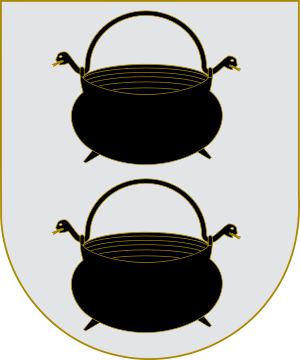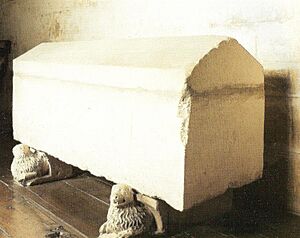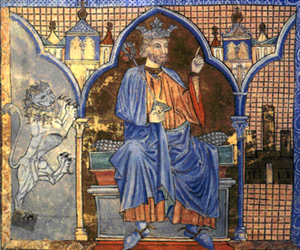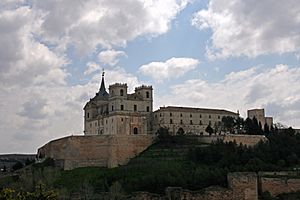Álvaro Núñez de Lara (died 1218) facts for kids
Álvaro Núñez de Lara (around 1170–1218) was a powerful nobleman from Castile. He played a very important part in the politics and wars of the Kingdoms of León and Castile around the early 1200s.
He became a count in 1214. He served as the alférez (a top military leader, like a royal standard-bearer) for King Alfonso VIII of Castile. Later, he was the regent (someone who rules for a young king) when King Henry I of Castile was a child. He also served as mayordomo (chief steward, managing the royal household) for King Alfonso IX of León.
Álvaro Núñez de Lara was against Queen Berengaria of Castile and her son King Ferdinand III. He supported the King of León during a war between Castile and León from 1217 to 1218. Towards the end of his life, he became a knight of the Order of Santiago, a group of knight-monks. He was buried in their Monastery of Uclés.
Contents
His Family Background
Álvaro's parents came from very strong families that were close to the royal family of León. His father, Count Nuño Pérez de Lara, was a regent for young King Alfonso VIII of Castile. His grandfather was Count Pedro González de Lara.
His mother, Teresa Fernández de Traba, was from the Galician House of Traba. She was also the half-sister of King Afonso I of Portugal. This was because their mother, Teresa of León, Countess of Portugal, was the half-sister of Queen Urraca.
When Álvaro's father died in 1177, his mother Teresa married King Ferdinand II of León. This meant King Ferdinand II became Álvaro's stepfather. Álvaro and his brothers grew up at the royal court with the future King of León, Alfonso IX.
Álvaro's brothers, Fernando and Gonzalo, were also important counts. They were key figures in the politics and wars of their time. Fernando was also a royal alférez for King Alfonso VIII. However, his big ambitions caused problems with the king, and he had to leave Castile. Gonzalo mostly worked in the Kingdom of León.
Early Career and Rise to Power
After his stepfather King Ferdinand II died, Álvaro moved to the Castilian court with his brothers. From 1196, he started signing royal documents. Around this time, the Lara family became close to Diego López II de Haro, a powerful lord. Álvaro likely married Urraca, Diego's daughter.
Álvaro took over as the royal alférez from his father-in-law in 1199. He served in this role until 1201, and again from 1208 to 1217. He fought alongside his brothers Fernando and Gonzalo in the famous Battle of Las Navas de Tolosa on July 16, 1212. He bravely carried the royal standard during this battle.
King Alfonso VIII was very grateful for Álvaro's courage in this battle, which was a major victory in the Reconquista (the Christian reconquest of Spain). On October 31, 1212, the king gave Álvaro the village of Castroverde de Cerrato. The king called him "my beloved and loyal vassal" and praised his service. Years later, in 1217, Álvaro gave this village to the Order of Santiago.
Becoming Regent
In 1214, King Alfonso VIII of Castile died. His young son, Henry, became king. Before he died, King Alfonso VIII had asked his daughter Berengaria and some church leaders to look after Henry and rule as regents.
However, some nobles felt that Berengaria's regency relied too much on certain bishops. They were unhappy with this situation. Many powerful lords decided that Álvaro Núñez de Lara should be the regent and take charge of the kingdom for the young king. Álvaro managed to get the young King Henry into his care. Berengaria reluctantly agreed to this.
With the agreement of the nobles and church leaders, Álvaro had to promise that he and his family would not take lands, start wars, or demand taxes without permission. The Archbishop Jiménez de Rada, a historian of the time, believed that the Lara family wanted to control the kingdom, just as Álvaro's father had done years earlier. It was during this time that Álvaro was made a count.
During his time as regent, Count Álvaro had problems with the church. He used his power unfairly, especially in 1215. He took advantage of several bishops being away at a big church meeting (the Fourth Lateran Council). He tried to take over their special rights and income. However, he later apologized publicly and promised not to do it again.
In 1216, Álvaro showed off his power by signing a document that said King Henry ruled Castile, but "Álvaro Núñez ruled the whole country under him." He started to push other nobles away from the center of power. For example, Gonzalo Rodríguez Girón, a high steward for 18 years, was removed. Other important nobles and the Archbishop of Toledo were also left out.
In the spring of 1216, Álvaro tried to get King Alfonso IX to make Queen Berengaria give up her castles. This might be why Berengaria sent her son Ferdinand to join his father. She wanted to make sure Ferdinand would be next in line for the throne of León.
Álvaro also arranged for King Henry to marry Mafalda of Portugal. But Queen Berengaria managed to get this marriage canceled by the Pope. Later, Álvaro tried to arrange for Henry to marry Alfonso IX's daughter, Sancha. If this marriage had happened, Henry would have become the heir to the throne of León.
In the autumn of 1216, Álvaro demanded that Berengaria hand over several castles, including Burgos and Valladolid. These castles were part of the arras (a gift given to the bride) that Alfonso IX had given her when they married. Berengaria asked her brother Henry about this, and he said he knew nothing about it. Henry was worried about Álvaro's actions and tried to meet with his sister. When Álvaro found out, he had Berengaria's messenger killed.
The chronicle of Jiménez de Rada says that Álvaro forged a letter from Berengaria, claiming she wanted to kill King Henry. This made opposition to Álvaro grow even more.
A Year of Great Tension in Castile
The year 1217 was very difficult in Castile. Álvaro, who was called the "royal standard-bearer and ruler of the king and kingdom," managed to get control of all the castles in the kingdom. He probably put his trusted people in charge of them. This made many nobles angry because they saw him gaining too much power.
The nobles who opposed Álvaro included the Meneses, Girón, Haro, and Cameros families. They stopped attending the Royal Council meetings. In February 1217, Álvaro traveled with King Henry to Valladolid, perhaps to try and avoid a war. Álvaro's new high steward sent a letter to Berengaria, asking her to give up the castles of Burgos and Valladolid. She gave up most of them, but not Valladolid.
Berengaria was staying at the castle of Autillo de Campos. Álvaro refused to give up his power. Many nobles gathered at Autillo to support Berengaria. Lope Díaz de Haro gathered about 300 knights in Miranda de Ebro. Álvaro sent his brother Gonzalo with a larger army. Luckily, the church leaders managed to stop a battle.
In March 1217, Álvaro, with his brothers and other nobles, invaded Tierra de Campos. This was where the Girón and Meneses families had their lands. They caused a lot of damage. They then went to the castle of Montealegre de Campos. Gonzalo Rodríguez Girón and Alfonso Téllez de Meneses came to help their relatives with their armies. But they avoided a fight when they saw that young King Henry was with Álvaro's forces. Alfonso Téllez de Meneses gave up his castle.
Later, Álvaro's troops attacked Autillo and Cisneros, where Berengaria and her supporters were. Lope Díaz de Haro and Gonzalo Rodríguez Girón went to the court of León to ask for help from Berengaria's son, Ferdinand. Meanwhile, King Henry lifted the siege of Autillo. Berengaria was forced to ask for peace and gave up the places that were under King Henry and Count Álvaro's control.
Death of King Henry I and Ferdinand III Becomes King
In May 1217, Álvaro was in the bishop's palace in Palencia with the Castilian court and King Henry. On May 26, the young king was playing in the palace courtyard when a tile fell from the roof and hit him on the head. This injury was fatal.
This accident marked the beginning of Álvaro's downfall. He tried to hide the king's death and took his body to the castle of Tariego. Berengaria found out about her brother's death almost immediately, likely from her spies. She took charge of getting her brother's body and bringing it to the family burial place in the Abbey of Las Huelgas in Burgos, where he was buried.
Meanwhile, Berengaria asked her son, Ferdinand, who was with his father King Alfonso IX in Toro, to come to her. She sent her most loyal supporters to convince Alfonso that Ferdinand needed to return to his mother. They did not tell Alfonso about the plans for Ferdinand to become King of Castile. They said the castle had been attacked. They managed to bring Ferdinand to his mother in Autillo, where he was soon declared king.
This was done without the full approval of the court and the councils of the most important towns of Castile. Berengaria immediately gave up her right to the throne in favor of her son. Ferdinand was declared king on July 2, 1217, in Valladolid.
War Between the Kingdoms and Álvaro's Defeat
Even though Berengaria was the oldest child of Alfonso VIII, Álvaro had claimed that Blanche of Castile, who was married to King Louis VIII of France, should become the next queen. He sent her a letter, but she refused and told Álvaro to give the castles he offered her to her sister Berengaria instead.
Berengaria and King Ferdinand quickly moved to Palencia. Ferdinand's troops went to Dueñas to start talks to end the fighting. Álvaro criticized Berengaria for crowning Ferdinand so quickly and asked to take care of him. Berengaria refused, even though the new king was almost 18. Álvaro's demands were ignored, and King Ferdinand and his group marched to Valladolid.
On July 4, two days after Ferdinand's coronation, his father, King Alfonso IX of León, invaded Castile. He took several towns. Meanwhile, Alfonso IX's son, Sancho Fernández, invaded Ávila but was pushed back. King Ferdinand tried to make a deal with his father, but Alfonso IX wanted to reunite the two kingdoms under himself and Berengaria.
The Castilians rejected this idea. Alfonso IX then headed towards Burgos to try and take the city. Berengaria and her supporters sent troops to protect Dueñas. Advised by Álvaro, Alfonso went towards Burgos, destroying lands along the way. He eventually decided to return to León because taking Burgos would be too hard. On his way back, he destroyed the lands of his enemies, the Girón and Meneses families.
Meanwhile, troops from Ávila and Segovia arrived to support King Ferdinand in Palencia. Ferdinand had already regained control of Burgos and other towns. In mid-August 1217, King Ferdinand entered Burgos and was cheered. Some fortresses still needed to be taken back, including Belorado and Nájera, which were loyal to Álvaro's brother Gonzalo.
In September 1217, King Ferdinand left Burgos for Palencia. Álvaro's brother Fernando tried to ambush the king's forces, but it failed. Álvaro tried another ambush. On September 20, the Meneses brothers and Álvaro Rodríguez Girón (Gonzalo's brother) surprised the Lara brothers. While his brothers escaped, Álvaro was captured. He was taken to Valladolid. To be released, he had to give up the fortresses he controlled, including Alarcón and Cañete.
Once Álvaro was back in León, where he was still the royal chief steward, the kings of León and Castile agreed to a truce in November 1217. Álvaro and his brother Fernando were part of this agreement. However, the peace did not last. Possibly encouraged by Álvaro, Alfonso IX invaded Castile again in the spring of 1218.
Álvaro tried to get back the castles he was forced to give up when he was captured. He offered to trade them for a fortress he had taken, but King Ferdinand III refused. Ferdinand III then resisted the invasions of the Laras, who convinced Alfonso IX to break the truce and attack Castile.
Alfonso's troops started from Salamanca. His son Ferdinand decided to invade León for the first time. However, they were soon forced to retreat and take shelter in Castrejón de la Peña. Alfonso and the Laras surrounded them. Álvaro, who was part of the siege, became very ill. He left for Toro, where he decided to join the Order of Santiago.
Death and Burial
According to one historical account, Álvaro Núñez de Lara fell ill and died in Castrejón. Another account says he was taken to Toro, joined the Order of Santiago there, and then died.
Marriage and Children
Álvaro married Urraca Díaz de Haro, the daughter of Diego López II de Haro. They did not have any children. In 1217, he gave some properties to his wife's aunt, Urraca López de Haro. This helped her to start the Abbey of Santa María la Real de Vileña.
He had four children outside of marriage with Teresa Gil de Osorno:
- Fernando Álvarez de Lara, who inherited the village of Valdenebro. His family later took their name from this village.
- Gonzalo Álvarez de Lara.
- Rodrigo Álvarez de Lara. He was a brave soldier and helped conquer Cordoba and Seville. He received lands for his service.
- Nuño Álvarez de Lara.
See also
 In Spanish: Álvaro Núñez de Lara (m. 1218) para niños
In Spanish: Álvaro Núñez de Lara (m. 1218) para niños






